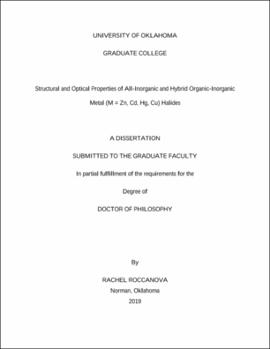| dc.description.abstract | All-inorganic and hybrid organic-inorganic metal halide materials, especially halide perovskites, have sparked the interest of the materials research community due to their excellent optoelectronic properties and their diverse tunable crystal structures and chemical compositions. APbX3 (A = Cs, CH3NH3; X = Cl, Br, I) perovskites prepared decades ago are today’s shining stars with CH3NH3PbI3 attracting attention as a solar cell material, and CsPbX3 and Cs4PbX6 as materials for radiation detector, display and lighting technology applications. Despite these notable achievements in the field, Pb-based perovskites suffer from lead toxicity and poor thermal, air and moisture stability which ultimately hamper their overall incorporation into marketable devices.
This dissertation largely focuses on non-Pb metal halide systems that have been underexplored in literature, primarily those based on group 11 and 12 metals (Cu, Zn, Cd and Hg). Thus, in Chapter 2, a summary of the results of investigations into the structural and optical properties of the (CH3NH3)2CdX4 (X = Cl, Br, I) family is provided in which we conclude that contrary to our expectations room temperature luminescence could not be achieved in this low-dimensional family. A summary of the studies on the (C5H7N2)2MBr4 (X = Zn, Hg) family is also presented in Chapter 2, where we found that by substituting a known emissive organic cation, we could obtain materials that demonstrate room-temperature luminescence resulting from simultaneous emission from both organic and inorganic units. In Chapter 3, the incorporation of a large bulky cation in the R-M-X (R = C15H26N; M = Zn, Cd; X = Br, I) family is reported. As a result, room temperature luminescence with quantum efficiency values up to XXX was achieved. Interestingly, light emission in this family was found to originate mostly from the organic cations. In Chapter 4, we show that the concept of dimensional reduction can also be applied to all-inorganic halides with the preparation and characterization of compounds in the CsX-CuX (X = Cl, Br, I) systems. Notable, the obtained materials include Cs3Cu2I5 that demonstrates a near-unity quantum efficiency blue emission at room temperature. Finally, the dissertation is concluded in Chapter 5 with a discussion of possible future directions. | en_US |

